 Image search results - "chinese" Image search results - "chinese" |

Manpukuji (萬福寺) is a large temple complex and headquarters of a Chinese Zen sect (Obaku-shu). It's one of the Big Three Zen sects in Japan (besides Soto and Rinzai).The founder was Chinese Zen master Yinyuan Longqi (Ingen) from Fujien Province in China who came to Japan via Nagasaki in 1654. Manpukuji (or Mampukuji) is part of the Japan Heritage for Uji tea history. A short walk from Obaku Station on the JR Nara Line and Keihan Uji Line.
|
|

Chinese-style Somon Gate (Important Cultural Property), the first entrance to Manpukuji. It's a quite a large temple complex with numerous buildings. A few of the major buildings are open to the public. 総門(そうもん)
|
|

Koma no Ashikage-en Monument in front of the entrance to Manpukuji temple. This can be roughly translated as "Hoof Print Field Monument." 駒蹄影園跡碑This monument is part of the Japan Heritage designation for Uji tea history.
|
|
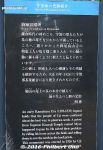
About Koma no Ashikage-en Monument. According to legend, local people in Uji pondered over how to sow the seeds to grow tea.It was then Priest Myoe (明恵), from the Kegon-shu Buddhist Sect, came on horseback and trotted on the field saying, "Plant the seeds in my horse's hoof prints." This monument was built by Uji tea growers in 1926 to express their appreciation to Myoe.
|
|

Lotus pond in front of Sanmon Gate. 放生池
|
|
|

The Sanmon main gate (Important Cultural Property). 三門(さんもん)
|
|

Sanmon main gate. 三門(さんもん)
|
|

At the Sanmon Gate, pay the admission to enter the temple. It's a very interesting temple, but they don't really have English explanations.
|
|

The Sanmon main gate (exit side). 三門(さんもん)
|
|

From Sanmon Gate, path to Tennoden Hall. The path is modeled after dragon scales.
|
|

From Sanmon Gate, path to Tennoden Hall. The path is modeled after dragon scales.
|
|

From Sanmon Gate, path to Tennoden Hall. The path is modeled after dragon scales.
|
|
|

Before going to Tennoden Hall, we turned left to this small gate leading to Kaizan-do Hall.
|
|
|

Karahafu roof gable
|
|

Karahafu roof gable
|
|

Very fine roof.
|
|

Manpukuji's Kaizan-do Hall (Important Cultural Property) where sect founder Yinyuan Longqi (Ingen) is worshipped. 開山堂(かいさんどう)
|
|

Chinese-style architecture is obvious with the roof corners curling upward.
|
|

Chinese design on the railing. Temple buildings are in Ming-style. Many buildings are Important Cultural Properties, but no National Treasures. 卍崩しのデザイン
|
|
|

Altar inside the Kaizan-do Hall.
|
|

Kaizan-do Hall
|
|

The big Sanmon Gate in the background.
|
|

Manpukuji has a lot of covered corridors linking the major buildings.
|
|

寿塔
|
|

石碑
|
|
|

Manpukuji corridor lanterns.
|
|

Manpukuji temple bell in a corridor.
|
|

Manpukuji temple bell in a corridor.
|
|
|

Tennoden Hall (Important Cultural Property). 天王殿(てんのうでん)
|
|
|

Inside the Tennoden Hall is Hotei, one of the Seven Gods of Good Fortune. 天王殿(てんのうでん)、弥勒菩薩(布袋)
|
|

Our Manpukuji priest guide admits his resemblance to Hotei and kindly posed next to it.
|
|
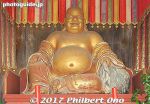
Inside Manpukuji's Tennoden Hall is Hotei, one of the Seven Gods of Good Fortune. 天王殿(てんのうでん)、弥勒菩薩(布袋)
|
|

Our Manpukuji priest guide spoke through our interpreter.
|
|

Statue behind the Hotei statue.
|
|
|
|
|
|
|
|
|
|
|
|
|
|
|

Corridor to Daiohoden Hall.
|
|

Daiohoden Hall roof.
|
|
|
|

Daiohoden Hall (Important Cultural Property), Manpukuji's main worship hall or temple. 大雄寶殿(だうおうほうでん)
|
|

About Daiohoden Hall.
|
|

Daiohoden Hall (Important Cultural Property), Manpukuji's main temple. 大雄寶殿(だうおうほうでん)
|
|

Chinese-style incense burner.
|
|

Round window at Daiohoden Hall.
|
|

Daiohoden Hall entrance.
|
|

In front of Daiohoden Hall.
|
|

Altar inside Daiohoden Hall, Manpukuji's main temple. It worships a sitting Shaka Nyorai or Gautama Buddha. 大雄寶殿(だうおうほうでん)
|
|
|
|

Shaka Nyorai or Gautama Buddha, founder of Buddhism. 釈迦如来座像
|
|
|

Chinese wooden fish drum for beating during prayers.
|
|

Side view of the Shaka Nyorai.
|
|

These mats on the floor are not for sitting. The priests stand behind the mats and chant.
|
|

Daiohoden Hall also has statues of the Eighteen Arhats. 十八羅漢像They are the original followers of the Buddha who have reached the state of Nirvana and are free of worldly desires.
|
|

Each arhat has a name.
|
|
|
|
|
|
|
|
|
|

Rear view of Daiohoden Hall.
|
|

Rear view of Daiohoden Hall.
|
|

Behind the Daiohoden Hall is Hatto Hall (Important Cultural Property) where Buddhist lectures are held. 法堂(はっとう)
|
|
|

Hatto Hall's bell-shaped window.
|
|

About Hatto Hall.
|
|
|
|

Manpukuji's famous fish board. 魚梆
|
|

Manpukuji's famous wooden fish board used like a gong to indicate the time. 魚梆
|
|
|

伽藍堂 (Important Cultural Property)
|
|

伽藍堂
|
|

Bell tower (Important Cultural Property)
|
|

About the Bell Tower
|
|

Prayer tablets (ema)
|
|

Women cleaning the sliding lattice doors before repapering.
|
|

Plum blossoms.
|
|

Near the Sanmon Gate is this entrance to Icho-an restaurant. 銀杏庵
|
|

Icho-an restaurant serves Chinese-style shojin-ryori (religious vegetarian cuisine) called fucha-ryori (普茶料理). This is another thing about Manpukuji. The sect's founder Ingen helped to spread Chinese cuisine in Japan from the 17th c.
|
|

Inside Icho-an. We could immediately tell that it was Chinese since the food was served on a turntable (Lazy Susan) which you can see in the photo.(This photo was taken after we finished lunch.)
|
|

Appetizers of our full-course, Chinese-style religious vegetarian cuisine at Icho-an. This plate was for four people. Very different, very colorful, and such a unique taste and deliciousness that I've never had before.Fucha ryori is healthy too. Well worth the ¥5,000 which I first thought was quite pricey for a religious meal with no meat. Got stuffed and we could take home some food too.
|
|

Fucha ryori became very popular after it was first introduced in Japan. No wonder. It looks exotic and tastes absolutely delicious. Salad.
|
|

Fucha ryori has no fish nor meat.
|
|
|
|

Rice was finally served at the end with pickles.
|
|

Dessert. One of the best meals I ever had in Japan. Advance reservations are required. It's not a walk-in restaurant. More info photos in Japanese: https://www.obakusan.or.jp/eat/
|
|

On my second visit to Manpukuji, I went with a group of foreigners and had lunch at the temple's restaurant Oryokaku (黄龍閣) serving Chinese-style shojin-ryori (religious vegetarian cuisine) called fucha-ryori (普茶料理).
|
|

"Obaku-san Fucha Ryori" bento-type (box lunch) fucha ryori for our large tour group. It costs around ¥3,000.
|
|

A simple bento (box lunch) fucha ryori at Manpukuji temple, Uji, Kyoto 普茶料理
|
|

Little pine cones at Manpukuji.
|
|

Lotus in a pot at Manpukuji temple.
|
|

Manpukuji also has a subtemple and treasure house called Hozoin (宝蔵院) noted for storing tens of thousands of woodblocks used for printing Buddhist scriptures.
|
|
|
|
|
|
|

Entrance to Hozoin.
|
|

Manpukuji also has a subtemple and treasure house called Hozoin (宝蔵院) noted for storing tens of thousands of woodblocks that are still used for printing Buddhist scriptures.
|
|

Tetsugen Doko (1630-1682), one of Ingen's Japanese disciples, started the project to make these printing blocks still used today.
|
|
|
|

Woodblock for printing Buddhist scripture. Looks very worn out.
|
|

Sample printings.
|
|

Buddhist picture print too.
|
|

Well
|
|
|
|

Marijuana leaf (or maybe maple leaf) design on this street gutter cover near Manpukuji. Probably hemp leaves, commonly used for making cloth.
|
|

"Curios" is an archaic term from the Meiji Period.
|
|

Fire hydrant manhole. Near Manpukuji, Uji, Kyoto.
|
|

Gate to Yomeien Garden, a Chinese-style garden.
|
|

Gate to Yomeien Garden
|
|

Yomeien Garden 陽明園
|
|

Yomeien Garden, Adogawa, Shiga 陽明園 MAP
|
|

Yomeien Garden 陽明園
|
|

Yomeien Garden 陽明園
|
|

Yomeien Garden
|
|

Next group I saw were these Chinese acrobats. First he uses a long whip to cut off the flower the little boy is holding.
|
|

Then two women do quick costume and mask changes.
|
|
|

This man did a few amazing balancing acts.
|
|
|

But the most amazing act was the final one, by this world-class Chinese acrobat.
|
|

She kept piling on these chairs. Good thing it wasn't a windy day.
|
|
|

The 36th Noge Daidogei Street Performance Festival in Yokohama, Japan featured a fantastic troupe of Chinese acrobats on April 24-25, 2010. 中国雑技芸術団
|
|

Then she balances herself on this high stack of chairs.
|
|
|
|

Wow...
|
|
|
|
|
|
|
|
|
|
|
|
|
|
|

Amazing. We were all in awe.
|
|
|
|
|
|
|
|
|
|

Ta-da!! And everyone applauded. What a show that was.
|
|

She's like wow...
|
|

Feb. 10, 2013 was the Chinese New Year's Day in Japan's largest Chinatown in Yokohama. Lion dances and firecrackers abound during the late afternoon and early evening. Gate near Ishikawa-cho Station.
|
|
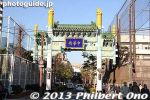
My first Chinese New Year in Japan, called "shunsetsu" in Japanese (春節). Glad to see that China-Japan relations are alive and well here, regardless of political differences.
|
|
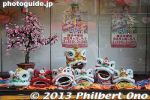
Chinese New Year window display.
|
|
|
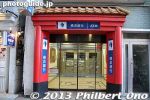
Local bank Chinese style.
|
|
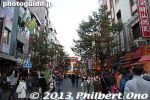
Walking toward Chinatown.
|
|
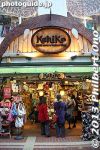
A Hawaiian shop in Yokohama's Chinatown?
|
|
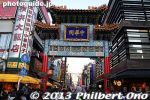
Another Chinatown gate.
|
|

Yokohama Chinatown was jammed with people on Feb. 10, 2013, Chinese New Year.
|
|
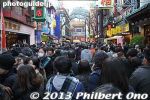
Dangerous for small kids and baby strollers.
|
|

It was especially crowded from 4 pm to 8 pm when they held the cai ching lion dances (saichin in Japanese 採青). Two guys in a Chinese lion danced at all the restaurants and shops in Chinatown. Four lions were there.
|
|

The lions jammed the streets with people wherever they went.
|
|

The lion danced for a few minutes in front of each shop or restaurant. They also went inside and danced. The first lion I saw was yellow.
|
|
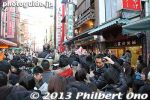
Crowd gathers wherever the lion is.
|
|
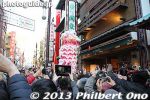
This lion was pink.
|
|

The lion dance was most dramatic when the lion stood up with one guy standing on the shoulders of the other. They are actually martial artists. The lion dance movements are similar to martial arts.
|
|

The lion plucks a red envelope containing money from each merchant.
|
|

My video of Chinese New Year at Yokohama Chinatown on Feb. 10, 2013.
|
|
|
|
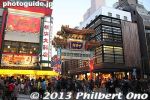
Yokohama Chinatown gate.
|
|
|
|
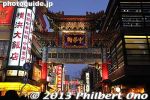
Yokohama Chinatown gate.
|
|
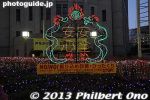
Illumination for safety and security
|
|
|
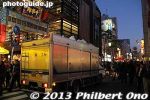
I couldn't believe that this big truck was trying to go through the crowds.
|
|

Chinatown gate.
|
|
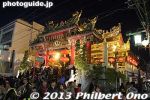
Yokohama Chinatown's main temple called Kwan Tai Temple (Kanteibyo in Japanese 関帝廟). Busy with Chinese New Year worshippers. Dedicated to Kwan Tei, a famous general in the ancient Chinese Imperial army and Taoist symbol of integrity and loyalty
|
|

Although the temple has been around for a long time, this building was built in 1990. Very ornate. Revered by merchants. Kwan Tai Temple (Kanteibyo in Japanese 関帝廟) in Yokohama Chinatown.
|
|
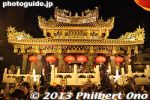
Kwan Tai Temple (Kanteibyo in Japanese 関帝廟) in Yokohama Chinatown.
|
|

Pay a fee to ring the gong.
|
|
|

Ornate roof of Kwan Tai Temple.
|
|

Dragon on Kwan Tai Temple.
|
|
|
|
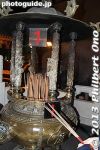
Incense burner at Kwan Tai Temple.
|
|
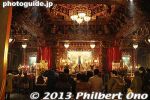
Inside Kwan Tai Temple.
|
|
|
|

Tree illumination and small pavilion at Yamashita-cho Park.
|
|
|
|
|
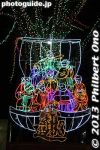
Gods of Good Fortune on a boat in lights.
|
|
|

Auspicious, gleaming souvenirs.
|
|

Your name in Chinese characters.
|
|
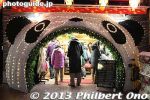
Panda entrance.
|
|

Lion bait.
|
|

Lion takes the bait.
|
|

Yokohama Ma Zhu Miao Temple (Masobyo in Japanese 横浜媽祖廟), dedicated to Mazu, the goddess of the sea and travel. The goddess spirit was split from a temple in Tainan, Taiwan.
|
|
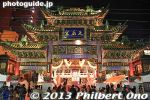
Yokohama Ma Zhu Miao Temple (Masobyo in Japanese 横浜媽祖廟) was built in 2006 to mark the 150th anniversary of Yokohama Port opening to foreign trade. Very ornate outside and inside.
|
|

Pay a fee to ring the gong and walk through the palanquin for good luck.
|
|
|
|
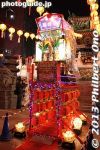
Palanquin at Ma Zhu Miao Temple (Masobyo) in Yokohama Chinatown.
|
|
|
|
|
|
|
|
|
|
|

Incesne burner at Ma Zhu Miao Temple Masobyo.
|
|
|
|
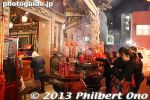
New Year's prayers at Ma Zhu Miao Temple Masobyo, Yokohama.
|
|
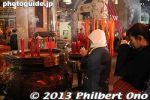
New Year's prayers at Ma Zhu Miao Temple Masobyo, Yokohama.
|
|
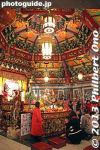
Inside Ma Zhu Miao Temple Masobyo, Yokohama. Pay a fee to enter.
|
|
|
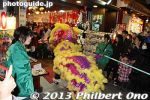
More lion dances.
|
|
|
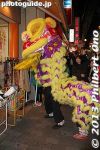
Chinese New Year at Yokohama Chinatown.
|
|
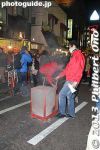
During Chinese New Year's, one Japanese word to learn is "bakuchiku" (爆竹). It literally means "exploding bamboo." Of course, we call it firecrackers. They pop firecrackers at least twice each time the lion dances.
|
|
|
|
|
|
|
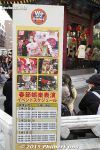
New Year's events held on the weekends following Chinese New Year's.
|
|
|
|
|
|
|
|
|

Chinese acrobat.
|
|
|
|